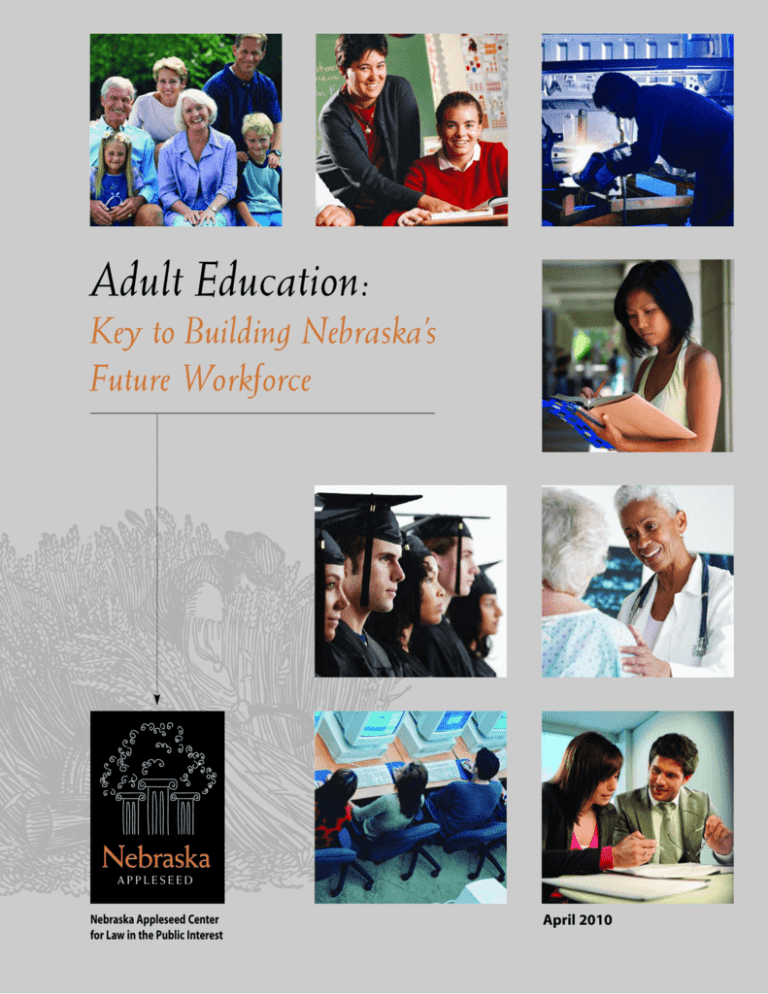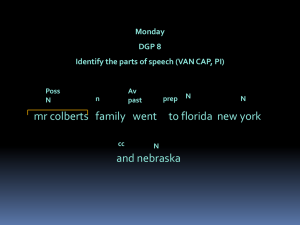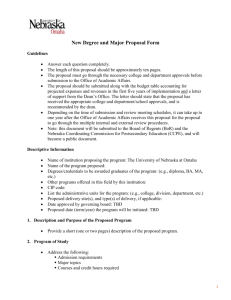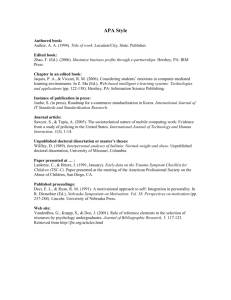Adult Education: Key to Building Nebraska's Future Workforce
advertisement

Adult Education: Key to Building Nebraska’s Future Workforce Nebraska Appleseed Center for Law in the Public Interest April 2010 About Nebraska Appleseed Center for Law in the Public Interest Nebraska Appleseed is a nonprofit, nonpartisan public interest law firm that works for equal justice and full opportunity for all Nebraskans. Appleseed uses litigation, public policy reform, and community education to positively impact low-income families, immigrants, children in foster care, and access to health care. Acknowledgements The Nebraska Appleseed Center for Law in the Public Interest would like to thank the national Working Poor Families Project, in association with Brandon Roberts and Deborah Povich, for their generous support of this project and much appreciated technical assistance. Nebraska Appleseed would also like to thank Jordan Milliken for her generous assistance in editing this report. Nebraska Appleseed is a part of the Appleseed network of independent, state-based, public interest law centers working to identify and address social injustices. The Appleseed network seeks to build a just society through education, legal advocacy, community activism, and policy expertise by addressing root causes and producing practical, systemic solutions with broad implications. For more information, visit www.appleseednetwork.org. Nebraska Appleseed Center for Law in the Public Interest 941 “O” Street, Suite 920 Lincoln, NE 68508 www.neappleseed.org ii Adult Education: Key to Building Nebraska’s Future Workforce Contents Overview . . . . . . . . . . . . . . . . . . . . . . . . . . . . . . . . . . . . 1 Economic Demand . . . . . . . . . . . . . . . . . . . . . . . . . . . . . 3 Educational Attainment and Economic Stability . . . . . . 5 Nebraska’s Adult Education System . . . . . . . . . . . . . . . . 7 Best Practices . . . . . . . . . . . . . . . . . . . . . . . . . . . . . . . . .11 Policy Recommendations . . . . . . . . . . . . . . . . . . . . . . .14 Appendix . . . . . . . . . . . . . . . . . . . . . . . . . . . . . . . . . . . .17 Citations . . . . . . . . . . . . . . . . . . . . . . . . . . . . . . . . . . . .18 Nebraska Appleseed Center for Law in the Public Interest / www.neappleseed.org iii Overview Adult Education programs are a key to building Nebraska’s future workforce and to helping our families, communities, and our state move ahead. Today, 80% of jobs nationwide currently require workers to have education beyond high school1. Jobs with future growth potential in Nebraska, including health care and business positions, require a workforce with strong basic skills. While Nebraska workers are among the most dedicated in the nation, many need new opportunities to gain education and skills they need to contribute fully to our workforce and to earn family supporting wages. In fact, more than one in five (22.5%) low-income families in Nebraska contains a parent without a high school diploma or GED2. Workers in our state are an essential part of building the “Good Life” today and ensuring our economic competitiveness in the future. The purpose of this report is to illustrate the vital role that adult education plays in building a future workforce and advancing family economic well-being in Nebraska, and to put forth proposals for improving our state’s system. Investing in adult education is an important strategy for building Nebraska’s workforce and for connecting low-income and low skilled workers to jobs that pay family supporting wages. These strategies position Nebraska to capitalize on our asset of working families to fuel economic development and state prosperity, contribute to the well-being of children and parents, and prepare our state to be a national leader during this period of economic recovery and beyond. Nebraska Appleseed Center for Law in the Public Interest / www.neappleseed.org 1 2 Adult Education: Key to Building Nebraska’s Future Workforce Economic Demand Need for Skilled Workers The Nebraska Department of Economic Development’s Annual report provides the results of a 2008 survey of business owners and managers about their current challenges and plans for expansion. The survey found that the top three difficulties for employers were “workforce availability, market competition, and increasing the customer base.” According to the report, “there is a continued lack of people to hire for positions in certain occupations.”3 In spite of a comparatively low unemployment rate, the lack of skilled workers in Nebraska continues. This prevents Nebraska from attracting new businesses and growing existing businesses. It is particularly concerning when we look towards the future, when our state will need to compete in the “knowledge economy” of the 21st Century, which will focus on technology and information sharing in a global marketplace. Nebraska’s need for a skilled workforce is a significant problem - both current and future occupations require workers with skills and education. In Nebraska, of the top ten occupations with the greatest expected growth from 2006-2016 only one, food preparation and serving workers, does not require a High School Diploma (or General Educational Development Diploma.) (Figure 1). Figure 1: Occupations with Greatest Numeric Change in Employment 2006-2016 with Education Level 4 Title 2006 Estimated Employment 2016 Projected Employment % Change Education Level Truck Drivers, Heavy and TractorTrailer 29,766 36,756 23.49% High School Diploma (or GED or High School Equivalence Certificate) Registered Nurses 20,429 27,323 33.75% Associate’s Degree (or other two-year degree) Customer Service Representatives 18,676 23,560 26.69% High School Diploma (or GED or High School Equivalence Certificate) Retail Salespersons 30,092 34,284 13.93% High School Diploma (or GED or High School Equivalence Certificate) Combined Food Preparation and Serving Workers, Including Fast Food 15,754 19,939 26.89% Less than a High School Diploma Bookkeeping, Accounting, and Auditing Clerks 20,693 24,181 16.86% Some college courses Nursing Aides, Orderlies, and Attendants 14,781 18,165 22.89% High School Diploma (or GED or High School Equivalence Certificate) Waiters and Waitresses 15,861 18,918 19.27% High School Diploma (or GED or High School Equivalence Certificate) Office Clerks, General 16,224 20,693 13.55% High School Diploma (or GED or High School Equivalence Certificate) Child Care Workers 9,637 11,964 24.15% High School Diploma (or GED or High School Equivalence Certificate) Nebraska Appleseed Center for Law in the Public Interest / www.neappleseed.org 3 Nebraska’s Adult Workforce In order to fill these jobs and meet Nebraska’s workforce needs, we must turn our attention to our current adult workforce. Two thirds of our 2020 workforce is already on the job today, but a significant number need new opportunities to gain education and skills5. In 2007, 97,300 adults aged 18-64 lacked a high school diploma or GED. This is equal to the combined statewide high school graduating classes of 2007-2011 assuming constant class sizes (Figure 2.) Further, the 2000 Census found 161,698 persons aged 16-60+ in the state without a high school diploma or GED – a large population that the Adult Education system works hard to serve. Figure 2: Working Age Adults - Key to Nebraska’s Economic Future 7 120,000 100,000 2011 80,000 2010 60,000 2009 40,000 97,300 2008 20,000 2007 0 All Nebraska Public High School Graduating Classes Added Togerther 2007-2011 Total Nebraska Working Age Adults Without a High School Diploma or GED 2007 Nebraska also faces a significant net outmigration of higher educated individuals. This trend, often referred to as “brain drain” is an issue that the state has faced over time (Figure 3). The outmigration of educated individuals, particularly those with High School Diplomas, contributes to the workforce shortages faced by Nebraska businesses. It also reinforces the need to increase access to Adult Education programs for those seeking to gain an education and build a better future in Nebraska. Figure 3: Estimated Nebraska Net-Migration of 22-to 64-Year-Olds in 2004, 2005, and 2006 by Education 8 -1,796 Graduate or Professional Degree 830 -1,329 670 Bachelor Degree -1,028 Associate Degree -923 -1,143 2,664 2,417 1,339 Some College, No Degree 943 3,897 -155 High School Graduate 2,295 -3,390 3,191 Less Than High School 2,234 1,524 -5,000 4 -2,500 0 2,500 5,000 Adult Education: Key to Building Nebraska’s Future Workforce Adult Education and Economic Stability Education, Unemployment, and Earnings Education is a key to economic security for families and for the state as a whole. An individual in Nebraska with a high school diploma or GED can expect to earn an average of $3,500 more per year than one without such a credential. Educational attainment is essential to a workers ability to find a job, it is also central to the state’s ability to attract and create high quality jobs. Additionally, workers with higher levels of education also tend to contribute more to state tax systems9. Increased personal income translates into more revenue for state investments and a stronger economy10. Adult education is essential to meeting workforce demand. It is also an important part of economic recovery. Unemployment rates for individuals without a high school diploma are more than twice that of those with some college or an Associate’s Degree (Figure 4.) In order to continue on the path towards economic recovery, we must develop opportunities for adults to gain skills necessary to re-enter and move up in the workforce. Figure 4: Nebraska Earnings and Unemployment Rate by Educational Attainment 2008 11/12 $60,000 $50,000 6% 5% 5.6% $40,000 4% 4.6% $30,000 3% 2.7% $20,000 $10,000 2.7% 2% 1.5% 1% $0 0% Less Than High School Diploma High School Graduate Some College or Bachelor’s Degree Graduate or Associate’s Degree or Higher Professional Degree Annual Income Unemployment Rate Education and Family Self-Sufficiency Education is an important strategy for moving families from poverty to self-sufficiency and economic stability. Currently, 60,210 working families in Nebraska are low-income. In other words, in spite of work, more than one in four Nebraska families (28.4%) struggle to meet their basic needs and get ahead13. These families contain one third (32.2%) of the state’s children14. A significant percentage, 22.5%, of those lowincome working families contains a parent with- Nebraska Appleseed Center for Law in the Public Interest / www.neappleseed.org 5 out a High School Diploma or GED15. 13.7% of low-income working families contain a parent that has difficulty speaking English well16. The average wage for an individual without a high school diploma in Nebraska is $20,99117. Nebraska’s Self-Sufficiency Standard measures the income that is needed for families in Nebraska to adequately meet their basic needs. It outlines, by county and family type, the costs of necessities such as child care, health care, and food and calculates the wage that a full-time worker must make in order to care for their family’s basic needs. In no county in the state is $20,991 a self-sufficient wage for an adult with a preschooler and school age child18. This means that families earning wages at this level may require public assistance and likely struggle to make ends meet. According to the “Family Bottom Line” report, the majority of families in Nebraska require far more than $20,991 to meet basic needs, regard- less of geographical area. The following chart illustrates the “Family Bottom Line” for multiple family types in metropolitan, non-metro urban, and non-metro rural areas (Figure 5.) In the future "knowledge economy" of the 21st century, it will be extremely difficult to gain and hold a job that pays a family-supporting wage without basic – and even post-secondary – educational attainment. An analysis by the Nebraska Department of Labor found 268 top high demand jobs that also pay high wages for the state.20 Of these 268 jobs, only 4 (1.5%) do not require at least a high school diploma or GED. The need for Nebraska to develop new opportunities for families to meet their potential through education and for Nebraska businesses to gain employees with basic skills is clear. Nebraska’s adult education system provides opportunities for both individuals and businesses, but has room to grow to meet future demand. Figure 5: Family Bottom Line for Multiple Family Types by Geographical Area 19 The Family Bottom Line in 2008 for Households with Two Adults 48,000 $26,716 $33,539 $32,817 $34,090 $28,494 Metropolitan 40,000 Non-metro Urban 32,000 Non-metro Rural < Federal Minimum Wage 24,000 < Federal Poverty Level 16,000 Preschooler Preschooler and Infant Schoolager and Preschooler Schoolager and Schoolager Teenager and Schoolager The Family Bottom Line in 2008 for Households with One Adult $24,303 36,000 $24,135 $25,181 $18,657 $28,494 Metropolitan 28,000 Non-metro Urban Non-metro Rural 20,000 < Federal Poverty Level < Federal Minimum Wage 12,000 Preschooler 6 Preschooler and Infant Schoolager and Preschooler Schoolager and Schoolager Teenager and Schoolager Adult Education: Key to Building Nebraska’s Future Workforce Nebraska’s Adult Education System Adult Education Success Story – Tim, Lincoln Nebraska I was a high school dropout for 20 years. I’d always wanted higher paying jobs, but only found closed doors. In those 20 years, I did make half-hearted attempts at a GED but found more excuses than motivation. In finally found that education is more important than goofing off. I was assigned a study location and met friendly teachers who were eager to help me. When I stopped thinking of how long it would take to complete my GED and started thinking only of the day I’d get it, T.I.M.E. (Things I must earn) went fast. In April 2006, I was awarded my high school diploma from the Nebraska Department of Education. With my newfound understanding about the importance of Education, I enrolled in college and currently have a 3.8 GPA1. 1. Nebraska Department of Education “Testimonials from some GED Graduates” http://www.nde.state.ne.us/ADED/GEDSuccessStories.htm Nebraska’s Adult Education Programs There are both economic and civic benefits of successful state Adult Education programs. Workers with higher levels of educational attainment are much less likely to be unemployed, to rely on public assistance programs, or to live in poverty-level household21. Increased levels of literacy are also associated with higher levels of participation in civic and community affairs, voting, and child educational achievement22. see appendix A.) Services include adult basic education, adult secondary education, high school equivalency completion, English as a Second Language programs, and workplace literacy programs. Figure 6 breaks down participation by program type. Figure 6: Participation by Program Type 2007-2008 23 Adult Basic Education 45% Nebraska’s Adult Education programs are administered through the Department of Education in partnership with community colleges, public schools, correctional institutions, and community based organizations. There are 21 programs statewide (for a listing of enrollment by provider, Adult Secondary Education 13% English as a Second Language 42% Adult Education Programs Defined Adult Basic Education: Programs and services that target adults functioning below the ninth grade level Adult Secondary Education (ASE): Programs and services that target adults functioning at the ninth grade level through the twelfth grade level English as a Second Language: Programs and services that target limited English proficient learners who have a focus on improving English communication skills in the instructional areas of speaking, reading, writing, and listening. High School Equivalency Completion: Programs targeting adults working to earn their high school equivalency degree (GED) Workplace Literacy: A program designed to improve the literacy skills needed to perform a job and at least partly under the auspices of an employer. Nebraska Appleseed Center for Law in the Public Interest / www.neappleseed.org 7 Funding Nebraska’s Adult Education programs are funded by a combination of federal, state and local dollars. The most significant portion, 73%, comes from federal investment. State dollars support the federal match, the programs with the largest proportion of Native American students, and volunteer coordination activities to recruit, train, evaluate, and manage volunteer tutors and instructors in programs statewide. Figure 7 outlines Nebraska Adult Education funding sources. Figure 7: Nebraska Adult Education Expenditures 2009 24 Federal Expeditures 71.5% Local Program Match 20.4% State Match 0.6% State Match Native American 0.2% State Match Volunteer Coordination 7.3% Demographics Nebraska’s Adult Education programs serve a wide variety of students. The majority of students are ages 25-44 – prime age for participation in the labor force. Another significant percentage are young people ages 19-24 seeking alternative ways to complete their GEDs or gain other skills (Figure 8.) As such, investments in these participants are investments in our current and future Nebraska workforce. Figure 8: Adult Education Program Participation by Age 2007-2008 25 16-18 yrs. 3% 19-24 yrs. 28% 25-44 yrs. 55% 45-59 yrs. 12% Participants enter programs at a variety of levels, many are employed and raising families, others are struggling with disability or unemployment. Figure 9 outlines the status of individuals entering adult education programs. 60+ yrs. 2% Figure 9: Adult Education Participant Status on Entry into the Program 26 Participant Status on Entry Into the Program Disabled Number 259 3,331 In Correctional Facilities Unemployed 1,766 In Community Correctional Programs Not in the Labor Force 3,406 In Other Institutional Settings On Public Assistance 575 SECONDARY STATUS MEASURES (Optional) Living in Rural Areas 492 Low Income In Family Literacy Programs In Workplace Literacy Programs In Programs for the Homeless In Programs for Work-based Project Learners 122 82 6 Number INSTITUTIONAL PROGRAMS Employed PROGRAM TYPE 8 Participant Status on Entry Into the Program 1,071 149 20 1,300 Displaced Homemaker 111 Single Parent 791 Dislocated Worker Learning Disabled Adults 63 129 122 Adult Education: Key to Building Nebraska’s Future Workforce Strengths and Challenges The Nebraska Adult Education Program has achieved federal performance benchmarks for four of the past six years. Specific successes include: • 45.2% of the adult learners who entered the program with a goal of getting a job achieved this goal in the first quarter after exiting the program. 47.5% of exiters with the goal of retaining a job or getting a better job did so. • 57.4% of the adult learners who entered the program with a goal of obtaining a GED diploma met this goal. • 40.1% of the adult learners who entered the program with a goal of entering postsecondary education obtained this goal by the end of the first quarter of FY 2010 (September 30, 2009)26. Program strengths identified by Adult Education Program Directors include a dedicated staff and connections to local organizations that provide match support27. However, here are currently 97,300 adults age 18-64 that do not have a High School Diploma or GED. In 2006 only 8,699 – or 8.9% received Adult Education Services28. A 2008 survey found that half of all adult education programs in the state had a waiting list29. Meeting the demand for adult education programs is a clear challenge for Nebraska, particularly in response to the economic downturn. Program Directors also identify the challenge of paying wages that draw well-trained, full-time instructors30. Student Challenges Adult Education Program Directors across the state identify multiple challenges for adult learners. First, many (39%) are balancing work and education31. Balancing work and family responsibilities, particularly in low-income households, can be a challenge to success in adult education programs. Many students are in need of supportive services such as transportation, child care, and GED testing scholarships to overcome obstacles to completion of a credential. Additionally, Adult Education Program Directors report increased occurrences of learning disabilities, requiring additional assistance and instructional time32. Nebraska Appleseed Center for Law in the Public Interest / www.neappleseed.org 9 Funding Gaps Nebraska serves only a fraction of the adults in the state without a High School Diploma or GED33. However, our investment in Adult Education programming has remained stagnant over time and is significantly lower than that of other states (Figure 10.) . Figure 10: Nebraska Adult Education Funding Over Time 34 Nebraska Adult Education Funding 2006 2007 2008 2009 Federal Expenditures $2,666,675 $2,808,689 $2,670,453 $2,339,389 Local Program Match $743,255 $755,637 $737,088 - $668,159 Total State Investment (State Match, Native American, Volunteer Coordination) $246,875 $247,252 $249,072 $263,180 A state match of 25% is required to receive federal funding. Currently, Nebraska matches at a rate of just 25.24%35. We invest $9.05 per adult without a High School Diploma or GED, ranking 43rd in the nation. Comparatively, the 10 national average is $65.5536. Nebraska should increase our investment in adult education programming to serve more students, with a priority focus on areas with waiting lists. Adult Education: Key to Building Nebraska’s Future Workforce Best Practices Adult education is an important first step towards building a prepared workforce. Nebraska’s Adult Education programs play a major role in developing the skills of adult learners and helping them move up the economic ladder. Given the need for skilled workers and the economic potential our workforce holds for the state, it is important to move our systems forward. The best practices highlighted in this section illustrate ways in which we can ensure that students and families succeed and transition effectively into employment and higher education. Support Services and Family Literacy Providing support services such as career counseling, child care, and transportation is a proven strategy to promote student success, particularly in persistence and completion. Such initiatives help students to balance work, family, and financial responsibilities with their educational goal37. In Mississippi the Learn More Earn More initiative provided support services including child care, transportation allowances, and GED testing fee scholarships to pilot programs in two community colleges. The initiative saw a 33% increase in GED completions and was awarded $1.5 million to promote the initiative statewide38. With many participants in Nebraska facing multiple barriers to participation, such as unemployment and disability, and significant percentage engaged in work and parenting activities, such an initiative could contribute to success for Adult Education students in our state. Family Literacy In Nebraska, Even Start Family Literacy programs in six communities across the state work to break the cycle of poverty and illiteracy and improve the educational opportunity of low income families by integrating intensive early childhood education, adult literacy or adult basic education including support for English language learners and parenting education. Even Start is a program of the US Department of Education administered through the NDE Office of Early Childhood. In 2007-2008, 141 families, including 160 adults and 208 children, were served across Nebraska. 57% of adult basic education participants improved at least one level and 64% obtained a GED39. The Even Start program successfully integrates adult learning, child learning, and parental education for families in our state. Expanding this program could maximize the impact of adult education programs to serve vulnerable families through both education and family supports. Nebraska Appleseed Center for Law in the Public Interest / www.neappleseed.org 11 Workplace Literacy Workforce literacy programs allow more lowincome workers to benefit from Adult Education programming while avoiding the barriers of transportation and child care they may otherwise face. Investments in ABE and English as a Second Language not only provide new opportunities for low-income women, minorities, and others in low-income working families, they can also help make Nebraska’s workforce more competitive. One example of a successful workplace education program is the Cargill Community Learning Center in Schuyler, Nebraska, which serves approximately 200 community members annually. See “Focus on: Cargill Community Learning Center” for more about this program. Focus on: Cargill Community Learning Center I will = I’ll. I will call my mother today. I’ll call my mother today. Contractions are the lesson of the day at the Cargill Community Learning Center. Understanding contractions is one more step towards a solid grasp of English for the diverse group of students in the classroom. They are young and old, single and parents, many are Hispanic but students at the center come from as far away as Thailand and as close by as the Schuyler community. The Cargill Community Learning Center provides educational opportunities for approximately 200 members of the Schuyler, Nebraska community annually. Located at the Cargill Meat Solutions processing center, the center serves employees and their families and is open to all community members. Cargill underwrites the program facilities, teachers, and supplies and contracts with Central Community College for fiscal oversight and other administrative duties. The program is held to the same standards as other programs statewide. 12 It is a highly successful and meaningful initiative. Students work on English skills, some earn GEDs; many also attend citizenship and driver’s preparation courses. At the halfway point of 2009, the program has an impressive 81% student retention rate. Another core benefit of the program is the development of stronger relationships among employees at the plant. The program’s success can be accounted for due to a number of factors: dedicated students and teachers, a committed workplace, and smart practices such as filtering new hires through the center during orientation and providing recognitions for students completing 100 hours of study. However, the impact is most clearly seen in the progress of students themselves. As one student explains, “I used to be so afraid to speak; now I am much more confident.” In all, the program is a clear example of the impact that adult education initiatives can have on individuals, workplaces, and communities. One step at a time. Adult Education: Key to Building Nebraska’s Future Workforce Career Pathways “Career Pathways” is a term that describes a framework for connecting customized education and training programs to the needs of the labor market. In career pathways programs, students move through contextualized education and training programs that lead towards a job in a high-demand industry with solid wages and opportunities for advancement. The Omaha Workforce Collaborative is one such initiative. One recent initiative with Mutual of Omaha and Blue Cross/Blue Shield recruited individuals to fill customer service positions. Participants received training from Metro Community College and Job Coaching from Goodwill Industries. The Omaha Workforce Collaborative successfully placed participants in the customer service positions, and is moving into welding and ophthalmology pathways programs. However, participants were required to pass a basic skills test in order to be considered for the program. 240 people applied and only 27 were invited to participate in the program. Career Pathways are a successful strategy to improving the skills of adults and fill workforce needs. Improving adult education programs to serve the needs of low-educated adults and connecting them to career pathways programs is a key strategy for Nebraska’s future workforce needs. Transition to Postsecondary A High School Diploma does not have the earning power it once did, nor will High School Diploma recipients fill the gaps in Nebraska’s future workforce. Therefore, High School Diploma or GED completion should be considered a step on a pathway to postsecondary education. A report by the Washington State Board for Community and Technical Colleges found that one year of post-secondary education and the attainment of a credential is a “tipping point” for family economic success – such individuals have a considerable average annual earnings advantage40. The state of Kentucky has set an explicit goal for their adult education system to increase the number of adult learners that transition to post-secondary education. This goal was set by the state legislature and outlines a pathway (and provides state funding) for students to transition to developmental education, and then on to postsecondary work. The implementation of these changes has led to a significant increase in the percentage of GED graduates that successfully transition to postsecondary education41. Nebraska Appleseed Center for Law in the Public Interest / www.neappleseed.org 13 Policy Recommendations Nebraska should increase our investment in Adult Education to contribute to building our state’s future workforce. Investments should increase participation, ensure quality, and create opportunities to transition to work and education. Nebraska should also set benchmarks for success and track outcomes through effective data collection. Increase State Investments in Adult Education Programming If Nebraska were to serve just one quarter of the adults in our state without a High School Diploma or GED we could increase the number of people in our labor force with basic skills by 24,325 – which would add up to more than a full graduating high school class. Increasing our investment in this system is necessary to meet the needs of adult learners and prepare them to meet the workforce demands of the future. Provide Opportunities to Make Improvements in Program Quality With an increasingly diverse student population, hiring skilled instructors with backgrounds in education is an essential component to quality programming. Providing opportunities to increase the intensity of instruction, through one-on-one teaching, smaller class sizes, and more class offerings and hours of instruction will also increase the quality and rate of progress for students. Finally, providing additional skills training opportunities for instructors will allow them to better respond to the changing and diverse populations they serve. Provide ongoing training for teachers 14 in effective teaching techniques is essential for program success – particularly, training for serving special needs populations and helping students become employment ready. Maximize Student Support Services Adult students are often balancing work and family responsibilities while pursing their educational goals. Support services such as transportation, career counseling, “soft skills” training, and, importantly, child care can all help students successfully reach their educational goals. Building a pilot program based on the Mississippi “Learn More Earn More” model would allow Nebraska to create an adult education supportive services system that works in our state. Expand Family Literacy Programs The Nebraska Even Start Family Literacy program is available in only six locations statewide. Barriers to increased participation mainly consisted of need for access to supportive services such as child care and transportation. Expanding availability of technical assistance and expanding the availability of the program to more communities statewide will improve educational opportunities for both parents and children in Nebraska. Transitions to Work The Cargill Community Learning Center illustrates the success that can be achieved in workplace literacy programs. Unfortunately, not all workplaces that would like to participate in literacy programs are able to provide the same opportunities as Cargill. Adult Education: Key to Building Nebraska’s Future Workforce The Indiana Adult Education Works program provides basic skills training to current employees and collaborates directly with businesses to create customized workplace programs. Indiana set aside one million in federal funds to implement a workforce grants program and to support three workforce specialists at the state level. The 2006-2007 Annual Report on Adult Education Works showed a return on investment of $3.06 for every dollar spent on the program. Implementing a similar workplace literacy grants program in Nebraska could meet the mutual needs of increasing educational opportunity and filling workforce needs in our state42. Transitions to Postsecondary Education Nebraska has a relatively small percentage (13%, or 1,096 students) of Adult Education participants participating in higher level Adult Secondary Education programs43. These students have the shortest path to attaining a GED and moving forward to postsecondary education. As a state, we should set clear goals to move a majority of these students on to college or another post-secondary education or training program. Providing targeted resources to develop transition programs for these students that involve career counseling and financial aid assistance could help our state move GED recipients into postsecondary institutions. Career Pathways Career Pathways programs like the Omaha Workforce Collaborative make transitioning into high demand, high paying jobs more feasible for low income adults. Career pathways programs provide an interconnected system of support services, educational access, and work experience. Career pathways are an important way to target workforce investments to future high demand jobs. Nebraska can invest in pilot projects to implement career pathways programs in high demand jobs across the state and ultimately develop multiple programs across the state. Track Success Data collection is an important piece of assuring and following student and program success. Moving forward, Nebraska should track all students and their successes at all levels, follow students for multiple years, track students across agencies and into the labor market, provide technical assistance to programs to do so, and use data to set benchmarks for progress. Specifically we should track the impact of adult education on student earnings and long-term job retention and follow the graduates that transition to post-secondary education and the percentage that obtain a degree or certificate as well as their ultimate earnings. Nebraska Appleseed Center for Law in the Public Interest / www.neappleseed.org 15 Summary Nebraskans believe that hard work should be rewarded and that people in our state deserve opportunities to turn their hard work into prosperity. Jobs of the future have the potential to provide such opportunities for Nebraska families and our economy as a whole. Investing in Adult Education programs is an important strategy to maximize the potential of Nebraska resi- 16 dents and the state. By investing in increased opportunities for people to access adult education, improving quality, providing family and student support services, supporting transitions to work and school, and tracking successes, Nebraska can leverage our state’s work ethic to build a strong successful workforce for the future. Adult Education: Key to Building Nebraska’s Future Workforce Appendix Enrollment by Provider Provider Name Enrollment 2007-08 Alliance Public Schools 86 Bellevue Public Schools 113 Blair Community Schools 13 Central Community College 1,518 Crete Public Schools 243 Literacy Center for the Midlands 32 Mid-Plains Community College 182 NAF Multicultural Human Development Corp * 127 Nebraska Department of Correctional Services – NE Correctional Center for Women * 157 NE Corrections Education Connection * 467 Northeast Community College 811 Omaha Metro Community College 2,009 Omaha Public Schools 918 Papillion LaVista Public Schools 68 Plattsmouth Community Schools 60 Sidney Public Schools * 21 SCC – Beatrice 246 SCC – Lincoln 1,202 Western NE Community College 216 York Public Schools 28 State Totals 8,517 * sites have been closed or consolidated for 2009 Nebraska Appleseed Center for Law in the Public Interest / www.neappleseed.org 17 Citations 1 The Workforce Alliance, “Federal Policy Recommendation, Adult Basic Education” http://www.workforcealliance.org/atf/cf/%7B9335395 2-1df1-473a-b105-7713f4529ebb%7D/ ADULT_BASIC_EDUCATION_FS_2009.PDF 2 Working Poor Families Project, “Working LowIncome Families with a Parent without a High School Diploma or GED,” Population Reference Bureau Analysis of 2007 American Population Survey 3 Nebraska Department of Economic Development, “Fiscal Year Annual Report July 1, 2007-June 30, 2008” http://www.neded.org/files/PIO/ann_rep/2008/2008N eDED_AnnualReport.pdf 4 Nebraska Department of Labor, “Occupational and Industry Projections, Nebraska, 2007-2009 Short Term Projects, 2006-2016 Long Term Projections” and Nebraska Career Compass, http://www.dol.nebraska.gov/nwd/center.cfm? PRICAT=2&SUBCAT=4C 5 Working Poor Families Project. “Strengthening State Financial Aid Policies for Low-Income Working Adults.” 2007 6 Working Poor Families Project generated from Population Reference Bureau analysis of 2007 American Community Survey 7 Nebraska High School Graduation rates based on “Kids Count Nebraska” Voices for Children Nebraska 2007 Graduation Number held constant http://datacenter.kidscount.org/data/bystate/ Rankings.aspx?state=NE&ind=2062 8 Nebraska Coordinating Commission for Postsecondary Education, “2009 Nebraska Higher Education Progress Report” 9 Ishwar Khatiwada, Joseph McLaughlin, Andrew Sum and Sheila Palma, “The Fiscal Consequences of Adult Educational Attainment”, National Commission on Adult Literacy, 2007 18 10 Dennis Jones and Patrick Kelly, “Mounting Pressure Facing the U.S. Workforce and the Increasing Need for Adult Education and Literacy”, National Commission on Adult Literacy, 2007 11 U.S. Census Bureau, 2008 Annual Community Survey 12 U.S. Census Bureau American Fact Finder http://factfinder.census.gov/home/saff/main.html?_ lang=en 13 Working Poor Families Project, “Working Families that are Low-Income,” Population Reference Bureau Analysis of 2007 American Population Survey 14 Working Poor Families Project, “Children in Low-Income Working Families,” Population Reference Bureau Analysis of 2007 American Population Survey 15 Working Poor Families Project, “Working LowIncome Families with a Parent without a High School Diploma or GED,” Population Reference Bureau Analysis of 2007 American Population Survey 16 Working Poor Families Project, “Working LowIncome Families with a Parent that has Difficulty Speaking English Very Well,” Population Reference Bureau Analysis of 2007 American Population Survey 17 U.S. Census Bureau American Fact Finder http://factfinder.census.gov/home/saff/main.html?_ lang=en 18 Nebraska Appleseed Center for Law in the Public Interest, “Self Sufficiency Standard for Nebraska,” updated 2007 19 Annemarie Bailey Fowler, Dr. Catherine Huddleston-Casas, Jon Bailey, and Erin Campbell, Opportunity at Work, “The Family Bottom Line,” 2009 20 Nebraska Department of Labor, “Nebraska Statewide High Wage, High Demand Jobs by Education and Training,” 2009 and Nebraska Department of Labor Career Compass Adult Education: Key to Building Nebraska’s Future Workforce 21 Sandy Baum and Jennifer Ma, “Education Pays: The Benefits of Higher Education for Individuals and Society”, Trends in Higher Education Series, Washington, D.C. The College Board, 2007 22 Rochelle Finzel, Indiana Institute for Working Families, “More than Just a GED: Improving Indiana’s Education System to Meet the Demand for Higher Skilled Workers”, 2008 23 Nebraska Department of Education 24 Nebraska Department of Education, “Adult Education Expenditures” 25 Nebraska Department of Education, Participants by Program Type and Age, 2007-2008 35 Working Poor Families Project, “StateAdministered Adult Education Program Fiscal Year 2006 Expenditures (July 1, 2006-September 30, 2008.)”, U.S. Department of Education, Office of Adult and Vocational Education (OVAE) 36 Working Poor Families Project, “StateAdministered Adult Education Program Fiscal Year 2006 Expenditures (July 1, 2006-September 30, 2008.)”, U.S. Department of Education, Office of Adult and Vocational Education (OVAE) and Working Poor Families Project from American Community Survey 2007 for Adults without a High School Diploma/GED 26 Nebraska Department of Education 37 Christopher Mazzeo, Brandon Roberts, Christopher Spence, Julie Strawn, “Working Together, Aligning State Systems and Policies for Individual and Regional Prosperity, December 2006 27 The Nebraska Appleseed Center for Law in the Public Interest, Survey of Adult Education Program Directors, August 6, 2009 38 Rebecca Dixon and Edward Sivak, “Adult Education: Gateway to a More Competitive Workforce,” Missippi Economic Policy Center, 2009 28 Working Poor Families Project, “StateAdministered Adult Education Program Fiscal Year 2006 Expenditures (July 1, 2006-September 30,2007.) 39 Nebraska Department of Education, Office of Early Childhood, “Even Start Family Literacy Program,” http://www.nde.state.ne.us/ech/even.html 29 Nebraska Department of Education 30 Nebraska Department of Education, Via E-mail 11/2009 31 Nebraska Department of Education, Via E-mail 11.2009 32 The Nebraska Appleseed Center for Law in the Public Interest, Survey of Adult Education Program Directors, August 6, 2009 33 Working Poor Families Project, “StateAdministered Adult Education Program Fiscal Year 2006 Expenditures (July 1, 2006-September 30,2007.) 34 Nebraska Department of Education Adult Education Expenditures FY 2006-2009 40 Washington State Board for Community and Technical Colleges, “Building Pathways to Success for Low-Skill Adult Students: Lessons for Community College Policy and Practice from a Longitudinal Student Tracking Study,” 2003 http://www.sbctc.ctc.edu/docs/data/research_reports/ resh_06-2_tipping_point.pdf 41 Kentucky Council on Postsecondary Education, “Kentucky Adult Education Report Card, 2005” http://cpe.ky.gov/NR/rdonlyres/3965DF5A-7E394C7C-B9B4-EFA5837CDFB0/0/KYAE2005Report Card.pdf 42 Rochelle Finzel, Indiana Institute for Working Families, “More than Just a GED: Improving Indiana’s Adult Education System to Meet the Demand for Higher Skilled Workers” 2008 43 Nebraska Department of Education 43 * Current data is unavailable for smaller population counties Nebraska Appleseed Center for Law in the Public Interest / www.neappleseed.org 19 Nebraska Appleseed Center for Law in the Public Interest 941 O Street, Suite 920 Lincoln, NE 68508 402.438.8853 402.438.0263 Fax info@neappleseed.org www.NeAppleseed.org







